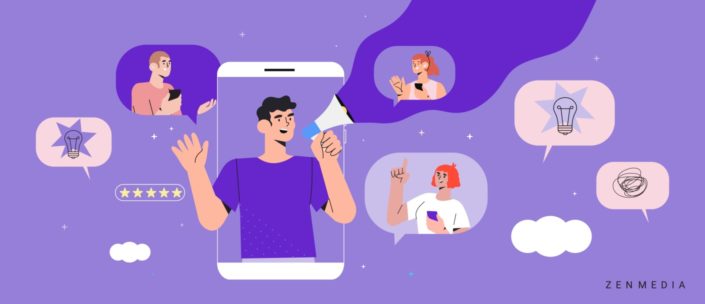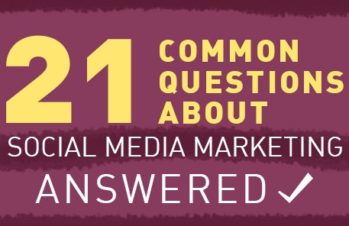The words social and media go together like peanut butter and jelly. But as marketers, maybe we’ve gotten a bit lazy in talking about social media as a ubiquitous space made up of a variety of platforms.
Marketers have focused on creating shareable content and getting it noticed on these platforms. We’ve talked about how these platforms have changed their algorithms and about new platforms that are making waves. But it’s time to talk about how social media has changed holistically and how it’s impacted our culture, and, of course, how marketing tactics and PR strategies need to adapt along with social media.
Ignoring the changes and operating as status quo is like making a sandwich with the same white bread and store-brand peanut butter and jelly when you have the option of fresh artisan bread, homemade nut butter, and hand-picked strawberry jam. It’s not that PB&J—or social and media—are breaking up entirely; they’re just re-defining the relationship.
Social and Media Are Splitting Up: Here's What That Means for Marketers Click To TweetSocial media began as a concept of online public communication platforms for users to interact with one another. But as the idea grew and more platforms popped up, brands got in on the action—and some users became brands themselves. Now the “social” and “media” aspects of social media are splitting.
The social of social media goes back to the roots of social media. It’s about users finding their friends, family members, and peers and interacting socially. We still use social media for these purposes, but now much of the social side of social media happens in the dark. We are moving away from public socialization and are taking our conversations to dark social—DMs, messenger apps, private groups, and other spheres where we can connect with a select few—often a select few that we know in “real life.”
On the other hand, social media has shifted away, in many ways, from socializing. It’s becoming more about “media” consumption. But the media, in this case, isn’t just news outlets—it’s us. People are the media now. When we aren’t socializing via these platforms, we’re consuming the content on the platform. Oftentimes, the content that users are consuming was created by someone they don’t personally know—an influencer, friend of a friend, or just someone random who showed up in their feed because they have a similar interest, hobby, or vocation.
The “media” side of social media, much like the traditional media, plays a big part in informing us and influencing our opinions and, ultimately, our decisions. But the “social” side is where people go to share and evaluate those decisions—Facebook messages with friends, Slack conversations with colleagues, or Discord chats with gaming buddies.
Related reading: Discord: What Is It and How Can You Use It For Marketing?
Our CEO and founder Shama Hyder says, “Social media isn’t just platforms, but it’s this idea that people are now the media.” Let’s explore what that means for marketers.
Embrace Dark Social
In our Dark Social Model, the gap between the loops of exploration and evaluation is an area called the Messy Middle, which we’ll talk more about in a minute. That area is where Dark Social lives. (That sounds a lot like the Upside Down in Stranger Things, but we promise there’s no demogorgon waiting to pounce.)
So why is it dark? Because marketers can’t really track it, leaving them largely in the dark about that section of the buyer’s journey. A customer might not even react or comment on a brand’s post before sharing it in a message to a friend to get their opinion. (As Stephanie Tanner would say, “How rude!”)
But seriously, as much as we’d like them to be, consumers aren’t concerned about letting marketers know their thoughts. They are concerned with evaluating their thoughts with trusted friends and colleagues, which is why they bring their conversations to dark social in the first place.
Related reading: Dark Social: What It Is and How To Deal With It
According to a June 2016 report from RadiumOne, 82 percent of content shared on mobile is shared through dark social, which is up from less than 50 percent in 2014. Imagine how much that number has grown since 2016!
As marketers, we know we don’t have the best tools to measure the impact of dark social and the ways in which buyers are communicating today. But just because you can’t measure it doesn’t mean it’s not valuable.
Integrate PR and Social Media Strategies
The new frontier for PR is heavily integrated with social media. It’s important to use social media to inform your PR campaigns, especially because there is a wealth of information on social media that can help shape your campaign strategy as you design it. Trending hashtags and most-talked-about topics in your audience’s newsfeed will tell you what they care about in live time, allowing you to connect with your audience more readily by building a campaign that addresses those conversations.
Showing media outlets that you are in touch with the latest and greatest for your common audiences will help build credibility with publications, improving your odds of getting placements. Since outlets are relying more on contributed articles than ever before, the more you can prove that your client can speak on trending topics, the more likely editors and publications will be reaching out for quotes, comments, and bylines.
Related reading: The Future of Public Relations: 12 PR Trends for 2022
And when you do get those PR hits, sharing them on social media will amplify your efforts and increase the lifespan of the hit. Need ideas on how to re-purpose a PR hit for social media in more ways than just sharing a link? We’ve got you covered. Check out our article detailing why PR and social media are forever intertwined.
Get Comfortable in the Messy Middle
When we talked about dark social earlier, we mentioned the Messy Middle was its home. According to a Google study, the messy middle is an untraceable area between consumers’ exploration and evaluation processes during their purchase journey. In addition to dark social, the messy middle includes the consumers’ own research and their offline conversations.
Is your heartbeat rising? Are you panicking that none of that sounds measurable? You’re right, but take a deep breath. There has always been a messy middle for consumers.
Marketers and advertisers of the past couldn’t measure watercooler conversations either, so there’s no need to fret. In fact, marketers today have a huge leg up on those of the past: social media. I know, I know, we just told you that so much of the buyer’s journey isn’t measurable, so what does it matter if you can still post to social media?
Increasing your share of voice by being present in your audience’s news feed while they are consuming on the “media” side of social media will ensure that they have access to share your content on dark social—and that you are in their minds when they begin thinking about making a purchase. You will organically become a part of their conversations in the messy middle, and even if you don’t know about it, that’s incredibly valuable.
So don’t be afraid of the peanut butter and banana sandwich or jelly and cream cheese toast. Even though the original concept has shifted, it’s still tasty—and change can be a good thing, as long as you’re ready to adapt along with it.







